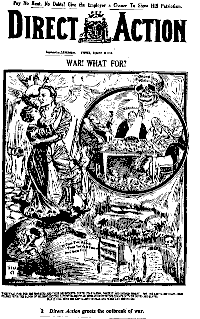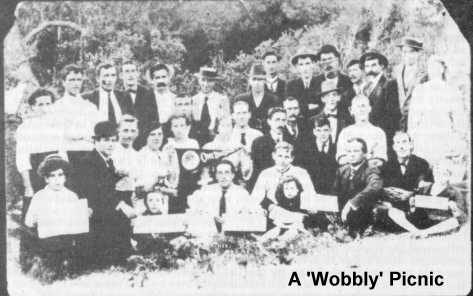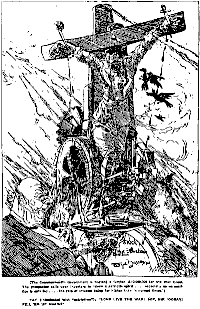




The major theme in the history of the I.W.W. in Australia was its ability, through working within established trade unions, to influence a significant section of them in a syndicalist direction and the possibility, had it survived initial state repression, that it would have gone on to syndicalize the organized working class movement in Australia. In arguing this thesis I will firstly define anarcho-syndicalism then I will sketch out the nature of the world anarcho syndicalist movement through outlining basic underlying convergencies and divergences within it. Finally, I will move onto an analysis of the Australian I.W.W.
I define anarcho syndicalism as the application of anarchist ideas of revolutionary organization to working class organizations ie. trade unions and community associations. These ideas are federalism and limited tenure of office. Federalism, meaning that the rank and file control the organization, as each member is autonomous and therefore can participate directly in all decisions made by it. On the local level, eg. the shop floor, these decisions are made by assemblies of the membership and by conferences of strictly mandated delegates when involving levels higher than the local i.e. provincial and national. Decisions are implemented by administrative committees. Their membership has a strictly limited (1) tenure of office, their functions are strictly defined and they are not paid, this enables administrative skills ie. secretarial, accounting etc. to be defused amongst the membership and prevents an elite which, due to its monopoly of skills, would be able to centralize power into its hands. The net effect of this way of organizing is to invest the rank and file with control over the direction of the day-to-day struggle and the power to initiate direct action. And hence through this mode of struggle, a revolutionary and anarchist consciousness will be developed amongst the rank and file. The achieving of limited gains eg. increased wages by their own power will facilitate in the rank and file the consciousness of the possibility of achieving greater gains ie. workers control of production and an anarchist society. I will now look at the nature of the world anarcho syndicalist movement. It consisted of both unions and propaganda groups. It also involved significant sections of the organised workers movement in both the industrialized and non-industrialized world. The epoch, in which it gained greatest international success was the period between the world depression and increased working class militancy of the 1890's and the period of world repression commencing at the beginning of W.W.l. The major convergence within the movement consisted of the member unions sharing anarcho syndicalist, as defined, aims and structures and a commitment to building unions based on industry rather than craft. This is shown by the adoption of approximations of the C.G.T.'s (the General Confederation of Trade Unions, the French anarcho syndicalist union set up in 1895 with a peak membership of 600,000) constitution -and preamble, by the other member unions of the movement.

Divergencies in the movement existed over the strategy to be used to build the workers movement on syndicalist lines. They were whether to work within existing reformist unions and convert them to syndicalism or to set up an alternative syndicalist union structure. Major proponents of these opposing strategies were the syndicalists within the French C.G.T., and the syndicalists within the U.S. I.W.W., set up in 1905 with a peak membership of 350,000. The French syndicalists had created the C.G.T. through the syndicalization of unions such as the construction workers, the N.E. metal workers and the affiliation of still reformist unions. In contrast, the U.S. I.W.W. was a dual union, a union set up in opposition to the established union structure (2). Its leadership believed that established unions, usually craft unions, could not he syndicalized and favoured that its members only hold I.W.W. membership cards. The other major differences within the movement were the reasons why workers joined its various member organizations and kinds of direct action to achieve the revolution. In relationship to the former difference, members joined the C.G.T. and the I.W.W. mainly for economic reasons, rather than explicit revolutionary commitment which was the case with the membership of the F.A.I., the Iberian Anarchist Federation, and the Industrial Syndicalist Education League in the U.K. Both organizations being major anarcho syndicalist propaganda groups, in their respective countries(3). In relationship to the latter difference, the kind of direct action to win the revolution, the I.W.W., C.G.T. and U.S.I. (Unione Syndicale Italiano) saw the means as the general strike, whilst the C.N.T. (the National Confederation of Labour, the Spanish anarcho syndicalist union) saw it as the insurrection and to a lesser extent the general strike (4).
The Australian I.W.W. was a national member of the movement I have just discussed. It was founded as a union in Adelaide in 1911, where its continental administration was also set up later that year, and which was later transferred to Sydney. The setting up of the union was the result of propaganda work by I.W.W. clubs set up since 1907 (5). These clubs were also a major determinant of the major theme in the Australian I.W.W.'s history ie. its adoption of the working from within established unions strategy to syndicalize the organized workers'movement and hence that members could carry both established union and I.W.W. cards and its achievements due to this policy. This approach was in contradiction to the U.S. I.W.W.'s dual unionism position. The above situation stemmed from the success of I.W.W. club members in terms of spreading syndicalist ideas within established unions. Some achievements of these clubs had been the Northern District Miners Federation of N.S.W. in August 1907 adopting the I.W.W. preamble and constitution and in 1908 a trade union congress in Sydney debating whether to adopt the I.W.W. constitution and preamble. Also contributing to the Australian I.W.W.'s adoption of the "boring from within strategy" was its lack of success in building the I.W.W. into a syndicalist union centre embracing large sections of the Australian working class. This failure was indicated by its small peak financial membership of only 11,000, that it had only one or two locals at any one time in any one industry, and that it had only created rudimentary structures of its dual union centre(6).
This relative failure of the I.W.W. due to the highly organized nature of the working class is in contrast to its relative success in terms of defusing syndicalist ideas within the organized labour movement. This success was facilitated by the growth in the number of I.W.W. locals and its establishment as a national organization, as by 1916 the I.W.W. had locals in all states of Australia, and key mining and industrial areas, and hence a base network from which to launch propaganda operations. The I.W.W.'s achievement was also contributed to by the existence of a militant working class media, its core being "Direct Action" the I.W.W.'s official organ, which had average weekly sales of 15,000, and a probable circulation of 45,000 - 50,000, its periphery being such papers as the militantly anti-capitalist, though racist "Bulletin". Such a media would act as a counter to bourgeois ideology, spread the syndicalist ideas or create a climate in which they could be accepted and act as a rallying point in times during which syndicalist influenced working class struggles took place.
 The character of this success consisted of the conversion of the trade union movement to anti conscription during W.W.l., the facilitation of amalgamations, and the diffusion of anti-bureaucratic, anti-arbitration system and direct action, especially general strike practices amongst unions. In relationship to the I.W.W.'s anti conscription activities we see that they caused the A.W.U. convention and the N.S.W. and Victorian A.L.P. conferences to oppose conscription and the organized workers' movement in general. As well the I.W.W. was admitted to representation on the special trade union congress called to devise means to oppose conscription (7). Overall their decisions prevented the conscription referendum from being passed. This achievement was of enormous significance as it made Australia the only country in the world to oppose conscription for W.W.1. In relationship to the I.W.W.'s contribution to the amalgamation of unions on industrial lines, the I.W.W. influences greatly the amalgamation of the N.S.W. Coal-miners Federation and the Victorian Coal-miner's organizations. As well, the I.W.W. was also the major influence behind the setting up of the Amalgamated Meat Industry Employees Union in Queensland, a union which showed many explicit syndicalist features. These included opposition to the arbitration system. This took the form of union enforced direct negotiation with employers by passing state wages boards established in 1910. Boards of control, analogous to shop committees, meetings of shop delegates, were the main initiators of policy. These boards also undermined the power of employers by being able to determine the pace of work, allocation of overtime and handled disputes that occurred. In relationship to the I.W.W. as a stimulant to direct action, it was the major influence behind A.M.I.E.U. direct action to protect itself from destruction by employers, who were incensed by its syndicalist features in 1918 (8). It influenced the Broken Hill miners, of whom many were wobblies, in their use of prolonged strike action to achieve their demands in 1916 and, as well, the I.W.W. provided the ideological climate for the 1917 general strike in N.S.W. in support of the strike of railways and tramways maintenance men to take place and in general the I.W.W. was the major catalyst for most direct action by unions from 1907 to the end of W.W.l.
The character of this success consisted of the conversion of the trade union movement to anti conscription during W.W.l., the facilitation of amalgamations, and the diffusion of anti-bureaucratic, anti-arbitration system and direct action, especially general strike practices amongst unions. In relationship to the I.W.W.'s anti conscription activities we see that they caused the A.W.U. convention and the N.S.W. and Victorian A.L.P. conferences to oppose conscription and the organized workers' movement in general. As well the I.W.W. was admitted to representation on the special trade union congress called to devise means to oppose conscription (7). Overall their decisions prevented the conscription referendum from being passed. This achievement was of enormous significance as it made Australia the only country in the world to oppose conscription for W.W.1. In relationship to the I.W.W.'s contribution to the amalgamation of unions on industrial lines, the I.W.W. influences greatly the amalgamation of the N.S.W. Coal-miners Federation and the Victorian Coal-miner's organizations. As well, the I.W.W. was also the major influence behind the setting up of the Amalgamated Meat Industry Employees Union in Queensland, a union which showed many explicit syndicalist features. These included opposition to the arbitration system. This took the form of union enforced direct negotiation with employers by passing state wages boards established in 1910. Boards of control, analogous to shop committees, meetings of shop delegates, were the main initiators of policy. These boards also undermined the power of employers by being able to determine the pace of work, allocation of overtime and handled disputes that occurred. In relationship to the I.W.W. as a stimulant to direct action, it was the major influence behind A.M.I.E.U. direct action to protect itself from destruction by employers, who were incensed by its syndicalist features in 1918 (8). It influenced the Broken Hill miners, of whom many were wobblies, in their use of prolonged strike action to achieve their demands in 1916 and, as well, the I.W.W. provided the ideological climate for the 1917 general strike in N.S.W. in support of the strike of railways and tramways maintenance men to take place and in general the I.W.W. was the major catalyst for most direct action by unions from 1907 to the end of W.W.l.
This wave of I.W.W. influence was abruptly concluded due to state repression and to some extent the Russian Revolution. The ferocity of the repression is an indication of the importance of the I.W.W. achievement and the terror it caused the ruling class. It took the form of frame-ups, i.e. the Sydney 12 trial, wobblies were charged with a conspiracy to burn down Sydney, and the Unlawful Associations Act of 1916, which made membership of the I.W.W. an offence punishable by six months in prison (9). These measures and the Russian Revolution, which lead to a reorientation of the radical workers' movement on anti-syndicalist lines, i.e. leninist, neutralized the relatively small number of conscious anarcho-syndicalist cadres (there were probably only a hundred or so), and thereby broke the syndicalist tide. This failure indicates the need of the I.W.W. to have more time to establish stronger roots amongst the working class and a more organized and more numerous anarcho-syndicalist core. And the need to re-orientate the I.W.W. organizationally from a union to a propaganda group. Given these changes, the syndicalist movement in Australia could have withstood state repression as the syndicalists in Spain have done on many occasions and could have gone on to syndicalize the organized workers movement in Australia.
In conclusion, we see that the Australian I.W.W. achieved significant successes in terms of spreading syndicalist ideas amongst the organized workers movement. And given more time to establish its base in the working class and possible rearrangements, it could have gone on to be successful in terms of achieving its historic project, the syndicalization of the working class and eventual revolution.